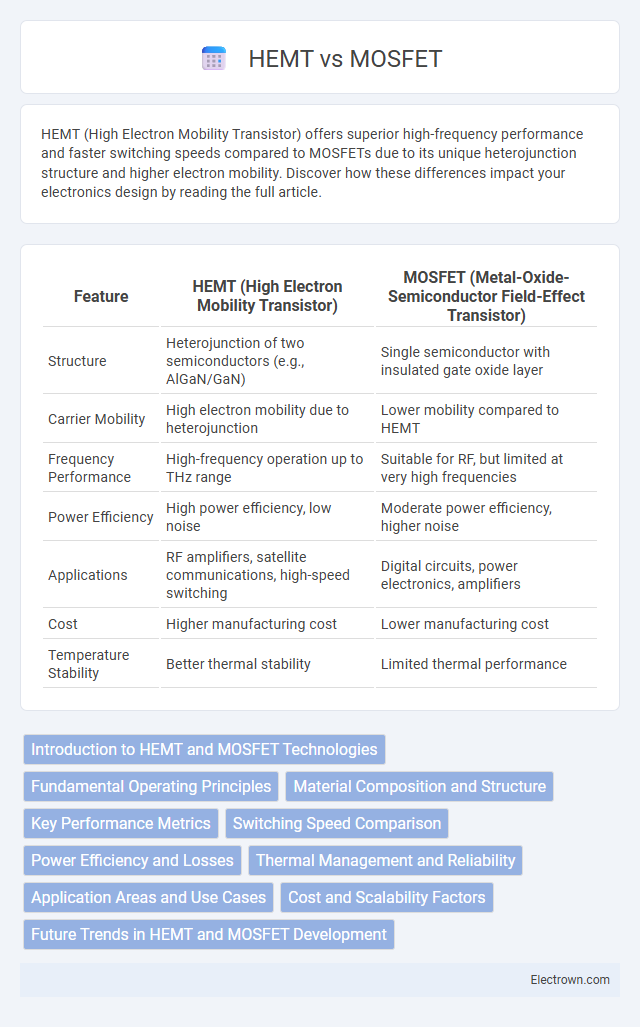HEMT (High Electron Mobility Transistor) offers superior high-frequency performance and faster switching speeds compared to MOSFETs due to its unique heterojunction structure and higher electron mobility. Discover how these differences impact your electronics design by reading the full article.
Table of Comparison
| Feature | HEMT (High Electron Mobility Transistor) | MOSFET (Metal-Oxide-Semiconductor Field-Effect Transistor) |
|---|---|---|
| Structure | Heterojunction of two semiconductors (e.g., AlGaN/GaN) | Single semiconductor with insulated gate oxide layer |
| Carrier Mobility | High electron mobility due to heterojunction | Lower mobility compared to HEMT |
| Frequency Performance | High-frequency operation up to THz range | Suitable for RF, but limited at very high frequencies |
| Power Efficiency | High power efficiency, low noise | Moderate power efficiency, higher noise |
| Applications | RF amplifiers, satellite communications, high-speed switching | Digital circuits, power electronics, amplifiers |
| Cost | Higher manufacturing cost | Lower manufacturing cost |
| Temperature Stability | Better thermal stability | Limited thermal performance |
Introduction to HEMT and MOSFET Technologies
HEMT (High Electron Mobility Transistor) utilizes a heterojunction interface to achieve high electron mobility, enabling superior high-frequency performance and low noise operation compared to MOSFETs (Metal-Oxide-Semiconductor Field-Effect Transistors). MOSFET technology relies on a metal-oxide gate structure on a semiconductor substrate to control current flow, offering widespread use in digital and power electronics due to its scalability and efficiency. The fundamental difference lies in HEMT's utilization of wide bandgap materials like GaN or AlGaN, enhancing speed and power capabilities beyond traditional silicon-based MOSFET devices.
Fundamental Operating Principles
HEMTs (High Electron Mobility Transistors) utilize a heterojunction interface between two semiconductor materials, creating a high-mobility two-dimensional electron gas (2DEG) channel that enables faster electron transport and higher frequency performance. MOSFETs (Metal-Oxide-Semiconductor Field-Effect Transistors) operate by controlling current flow through an inversion layer in a single semiconductor substrate, modulated by the voltage applied to the gate oxide. The fundamental difference lies in HEMT's reliance on heterostructure-induced high electron mobility versus MOSFET's use of gate-induced channel inversion in a homojunction structure.
Material Composition and Structure
HEMTs (High Electron Mobility Transistors) utilize compound semiconductors such as gallium arsenide (GaAs) or gallium nitride (GaN) with a heterojunction interface between different materials, creating a high-mobility two-dimensional electron gas (2DEG) channel. MOSFETs (Metal-Oxide-Semiconductor Field-Effect Transistors) are typically fabricated using silicon with a silicon dioxide (SiO2) insulating layer and a single semiconductor channel. The heterostructure in HEMTs enhances electron mobility and frequency response compared to the uniform silicon channel in MOSFETs, resulting from the distinct material compositions and layered structures.
Key Performance Metrics
High Electron Mobility Transistors (HEMTs) outperform Metal-Oxide-Semiconductor Field-Effect Transistors (MOSFETs) in key performance metrics such as higher electron mobility, faster switching speeds, and superior frequency response, making them ideal for high-frequency and high-power applications. HEMTs exhibit lower on-resistance and reduced noise figures, which enhance efficiency and signal integrity in RF and microwave circuits. MOSFETs, while generally offering better scalability and cost-effectiveness for digital and low-frequency applications, fall short in achieving the ultra-high speed and low noise characteristics essential for advanced communication systems.
Switching Speed Comparison
HEMT transistors offer significantly faster switching speeds than MOSFETs due to their high electron mobility and lower gate capacitance, making them ideal for high-frequency applications. MOSFETs exhibit slower switching times because of higher gate charge and channel resistance, which can limit performance in rapid switching circuits. Your choice between HEMT and MOSFET should consider the specific switching speed requirements of your electronic system for optimal efficiency.
Power Efficiency and Losses
HEMTs (High Electron Mobility Transistors) offer superior power efficiency compared to MOSFETs due to their higher electron mobility and lower on-resistance, resulting in reduced conduction and switching losses. HEMTs excel in high-frequency, high-power applications, minimizing energy loss and enhancing overall system performance. Optimizing your design with HEMTs can significantly improve power efficiency in demanding electronic circuits.
Thermal Management and Reliability
HEMT devices exhibit superior thermal management due to their wide bandgap materials like GaN, enabling higher temperature operation and enhanced power density compared to silicon-based MOSFETs. Your system benefits from HEMT's improved reliability under high thermal stress, as these transistors maintain stable performance and longer lifespans in harsh environments. MOSFETs, while cost-effective, typically require more extensive cooling solutions to manage thermal dissipation and sustain operational reliability.
Application Areas and Use Cases
HEMTs excel in high-frequency, high-power applications such as RF amplifiers, satellite communications, and 5G technology due to their superior electron mobility and low noise. MOSFETs are widely used in digital circuits, power management, and switching applications, including microprocessors, power supplies, and motor controllers, thanks to their ease of integration and cost-effectiveness. Understanding your specific needs helps determine whether the high-speed performance of HEMTs or the versatile, cost-efficient MOSFETs are best for your application.
Cost and Scalability Factors
HEMT devices typically have higher fabrication costs due to complex materials like GaN or GaAs, whereas MOSFETs benefit from mature silicon processes that drive down expenses. Scalability favors MOSFETs as silicon-based manufacturing allows for extensive integration and mass production, improving cost-efficiency for large volumes. Your choice depends on balancing the premium performance of HEMTs against the economical and scalable advantages of MOSFET technology.
Future Trends in HEMT and MOSFET Development
Future trends in HEMT and MOSFET development focus on enhancing power efficiency and switching speeds for next-generation electronics. Researchers are exploring wide-bandgap materials such as GaN and SiC to improve thermal performance and high-frequency operation in HEMTs, while MOSFET innovation centers on scaling down device sizes and integrating advanced gate dielectrics to reduce leakage currents. Your choice between these technologies will depend on application-specific requirements like power density and frequency response.
HEMT vs MOSFET Infographic

 electrown.com
electrown.com